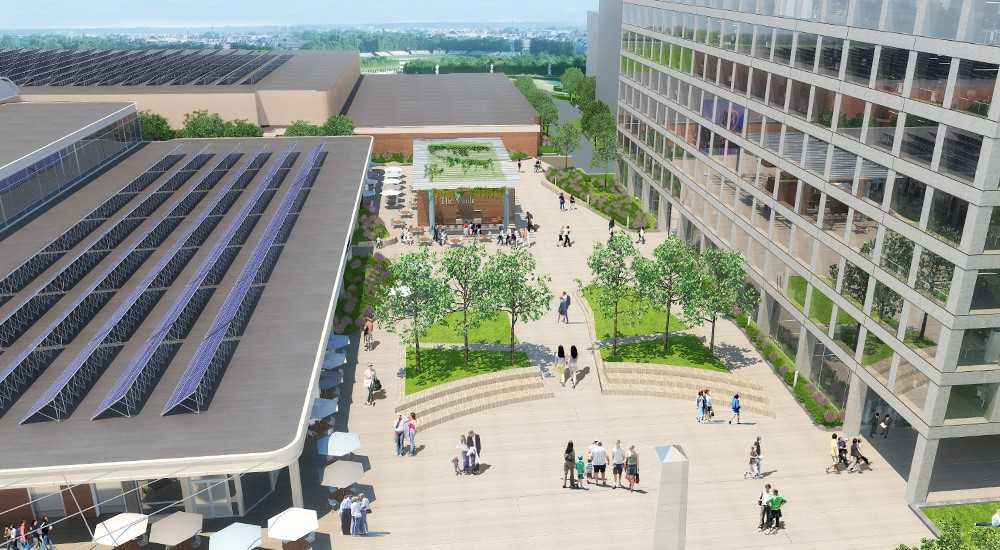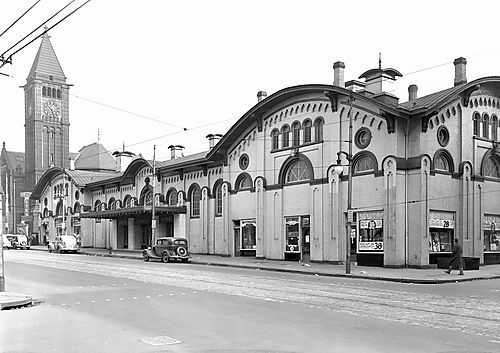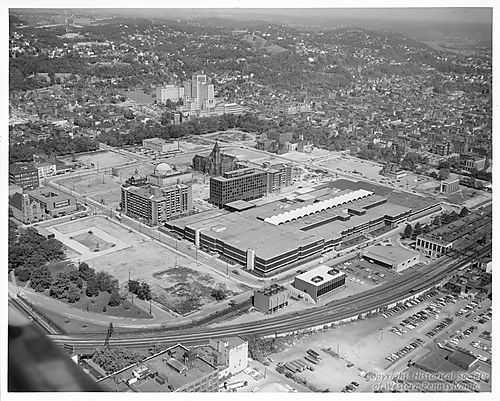Secret Pittsburgh
Allegheny Center: Renewal or Decay?
By Madeline Kulp
Allegheny City, now known as Pittsburgh’s North Side, has a long and complicated history of change. While initially a thriving and unique city of its own, it soon became a rundown neighborhood blighted by urban decay. Today, looking back, it is difficult to know whether the changes that the space has undergone should be seen as positive or negative. As a case study, the shopping centers of Allegheny Center provide insight into the changes that the neighborhood has gone through and how they have affected the community as a whole.
The Old Allegheny Market House, built in 1863, serves as a memorial to the rise and fall of Allegheny City. While serving the common every-day function of a food market, the building’s grand Romanesque and Italianate architecture style, filling an entire city block, made it an imposing and beautiful structure. Allegheny City, located north of the Allegheny River right across the water from the nearby and much more crowded Pittsburgh, thrived through the nineteenth century. The photo of the Market House reflects the flourishing of this community, with its wide open boulevard in the foreground, the highlighting of the luxurious architecture of the building, and the opulent Carnegie Library in the background. The street is crisscrossed with street-car wires and dotted with the latest automobiles. Signs in the high arched windows advertise everything from a watchmaker to a nut shop. A man in a dark suit and hat walks toward the building as if eager to take advantage of all the city has to offer. In short, the photo is full of hope for the city and expressions of affluence.
In time, the Market House came to be a sad reminder of what used to be. First, the proud Allegheny City lost its independence when it was annexed into the City of Pittsburgh in 1907. Then, after the boom in the steel industry of World War II, the area fell on hard times and many of the more well-off residents abandoned their formerly magnificent urban houses for the suburbs. Finally, in the 1960’s, the City of Pittsburgh attempted an ambitious urban renewal project to completely renovate and reimagine 79 acres of what is now Pittsburgh’s North Side. One of the buildings that was destroyed in the project was the old Allegheny Market House, by then just a hundred-year-old decaying memory of the good times now far in the past.
The goal of the renovation project in the North Side was the creation of a complex of housing, public parks, and retail space known as Allegheny Center. A prominent feature of this new space was Allegheny Center Mall, a modern shopping center with four levels and seventy-four store fronts designed to attract shoppers from all over the city and jumpstart the North Side economy. At the time, it was one of the largest malls in the United States. In the photo, Allegheny Center can be seen as it stood in 1968, with some of the planned buildings not yet complete. The mall is the dominant feature, taking up almost half of the square with its imposing, flat, and dull roof. The bare and uninviting patch of land that is Allegheny Center, dotted with undeveloped lots of dry earth, is surrounded by other parts of the North Side covered with trees and the unique flavor of a neighborhood built up by time. Allegheny Center, however, in this picture, lacks this flavor and rich past, its history replaced by renovation.
Although the mall saw some success in the 1970’s and 80’s, it saw a huge decline in use as it was replaced by bigger and better malls of the suburbs. Contrary to the hopes of the Pittsburgh Urban Redevelopment Authority that spurred the construction of Allegheny Center, the mall did not bring prosperity and new life to the North Side. In reality, the problems of poverty, urban decay, and crime were still very much present in the community. Over time, the many store fronts emptied out one by one and left the once hope-filled mall desolate. Eventually the vacated building was transformed into office space. The last store of the mall closed in 2004, completing the transition.
While the two images capture the same space, they do so in very different ways. The first image takes a close-up perspective of the Old Allegheny Market House, highlighting the beautiful building and its integration into the community, with street car lines, cars, and people clearly visible. It is more focused on celebrating the building itself than the surroundings. The second picture, on the other hand, seems contrived and impersonal. It captures very precisely the square chunk of land being transformed into Allegheny Center as if to analyze it or advertise it. The focus is not on celebrating the individual buildings or on aesthetic beauty, but on the newness and bigness of this urban renewal endeavor that proudly erases what has come before.
In 2015, a new plan to revitalize the North Side was announced. Instead of an official city effort, this change came from the private sector. Faros Properties purchased the old Allegheny Center Mall with a view toward turning it into a thriving community center and technology hub called Nova Place. According to its website, the main goals of Nova Place are to revitalize the community and to connect the struggling North Side to thriving downtown Pittsburgh. According to Jeremy Leventhal, Managing Partner of Faros Properties, “We’re taking what was a failed development and attempt at 1960s urban renewal, which was really destructive to Allegheny City because it bulldozed the entire thing and the community, and trying to reintroduce that through our own redevelopment lens, through the fabric of the community.” In other words, far from being just an office space that houses businesses, Nova Place is to be a cultural hub that interacts with and builds up the local community that it is a part of. Other features of the space include a fitness center, restaurants, and new housing units. As of 2016, fifty companies were utilizing Nova Place.
The current residents of the North Side, especially those with a long heritage connected to the area, must reconcile the drastic differences between past and present and what their own connection to the place entails. Michel De Certeau in his book The Practice of Everyday Life, says, “There is no place that is not haunted by many different spirits hidden there in silence […] Places are fragmentary and inward-turning histories, pasts that others are not allowed to read, accumulated times that can be unfolded but like stories held in an enigmatic state”(108). Allegheny City, certainly, was one place imbued with deep meaning and history known and cherished by the people that lived and worked there. The Urban Renewal developers, coming in from the outside, did not see the beauty of this lived experience and history, but only a place blighted by urban decay and needing complete reimagining. So, after the transformation of what once was space imbued with meaning into neutral and uncharted new space, what remains? Only memories remain. These memories may take the form of archived photos that preserve the stories and meanings created by the inhabitants through a depiction of the physical space. As Berger says in About Looking, “Memory implies a certain act of redemption. What is remembered has been saved from nothingness. What is forgotten has been abandoned” (58). So, in preserving what used to be, archives and photos allow a trace of the past remain. They preserve the beauty of what once existed in Allegheny City and let the current residents connect and interpret this past in light of the present.
With its long history of change and continual rebirth, the North Side of Pittsburgh will continue to seek out its identity and a place in the diverse neighborhood complex of Pittsburgh. While the new vision brought in by spaces like Nova place seems fresh and exciting, time will tell what effect new endeavor will have on the old community, and how much of the old will be preserved and integrated into the new.
Works Cited
Aerial View of Allegheny Center. Digital image. Historic Pittsburgh. Heinz History Center, 26 Sept. 1968. Web.
Belko, Mark. "Developer Plans to Turn North Side's Allegheny Center into Technology Hub." Pittsburgh Post-Gazette. N.p., 21 May 2014. Web.
Berger, John. “Uses of Photograpy.” About Looking, Bloomsbury, 2009.
Certeau, Michel De. “Walking in the City.” The Practice of Everyday Life, Univ. of California Press, 2008.
Exterior of North Side Market House. Digital image. Historic Pittsburgh. University of Pittsburgh, 1 Mar. 1936. Web.
Homren, Wayne. "Allegheny City and Its Tokens – Gone But Not Forgotten." NovaNumismatics.com. N.p., 6 Nov 2014. Web.
Strebig, Niel. "Allegheny Center, a History of Change." Northside Chronicle. N.p., 31 Mar 2016. Web.
"The Next Page: Reviving the North Side's 'Lost City'." Pittsburgh Post-Gazette. N.p., 8 April 2007. Web.


